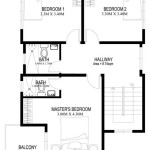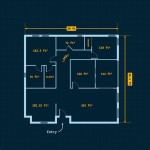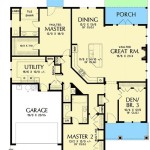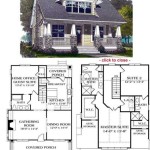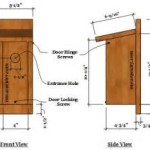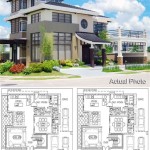1 Bedroom House Floor Plans With Dimensions: Maximizing Space and Functionality
The demand for efficient and affordable housing has spurred the creation of innovative 1-bedroom house floor plans. These designs must maximize space and functionality within a compact footprint. Understanding the considerations involved in designing a 1-bedroom house plan, with careful regard to dimensions, is essential for homeowners, builders, and designers alike.
This article explores various aspects of 1-bedroom house floor plans with dimensions, highlighting key design elements, space-saving strategies, and considerations for different lifestyle needs. It will delve into the importance of precise measurements and how they impact the overall usability and comfort of the living space.
Key Considerations in 1-Bedroom House Design
Developing a successful 1-bedroom house floor plan requires careful consideration of several key elements. These elements contribute to the overall livability and functionality of the space.
Space Optimization: In a 1-bedroom house, every square foot counts. The design must prioritize efficient use of space, minimizing hallways and maximizing open areas where possible. Multi-functional furniture and built-in storage solutions become crucial for creating a clutter-free environment. The placement of fixtures and appliances should be carefully considered to optimize workflow and prevent wasted space. For instance, a kitchen island can serve as both a food preparation area and a dining space, thereby eliminating the need for a separate dining table in smaller units.
Natural Light and Ventilation: Adequate natural light and ventilation are essential for creating a comfortable and healthy living environment. Windows should be strategically placed to maximize sunlight exposure and promote cross-ventilation. Skylights can also be incorporated to bring natural light into areas that may not have direct access to windows. Furthermore, proper ventilation helps to prevent moisture buildup and improve indoor air quality, both of which are crucial for maintaining a healthy living space. The orientation of the house on the lot can also impact the amount of natural light received at different times of the day.
Privacy and Functionality: While a 1-bedroom house is typically designed for single occupants or couples, the design must still consider the need for privacy within the limited space. Separating the bedroom from the living area is crucial for creating a sense of sanctuary and allowing for undisturbed rest. The bathroom should be easily accessible from both the bedroom and the living area. A well-defined entry space can also help to create a sense of separation between the inside and outside worlds, providing a buffer from noise and distractions. The functionality of each space should be carefully considered based on the occupant's lifestyle and needs. For example, a home office area may be necessary for those who work remotely.
Accessibility: If the design is intended for aging in place or individuals with disabilities, accessibility considerations are crucial. This includes wider doorways and hallways to accommodate wheelchairs or walkers, grab bars in the bathroom, and lever-style door handles. Universal design principles should be incorporated to ensure that the house is accessible to people of all ages and abilities. This may also include features such as roll-under sinks and countertops, adjustable-height shelving, and ramped entrances.
Analyzing Common 1-Bedroom Floor Plan Layouts
Several common layouts are prevalent in 1-bedroom house designs, each with its advantages and disadvantages. Understanding these layouts can help in making informed design choices.
Linear Layout: This layout features a long, narrow design with rooms arranged in a linear fashion. It is often used in apartment buildings or row houses where space is limited. The bedroom is typically located at one end of the house, with the living area and kitchen situated at the other end. This layout can be efficient in terms of space utilization, but it may lack natural light in the central areas of the house. Careful consideration must be given to window placement and artificial lighting to ensure that all areas are adequately illuminated. The linear layout can also feel cramped if not designed properly, so careful attention should be paid to the dimensions of each room.
Open Concept Layout: This layout combines the living area, dining area, and kitchen into one large, open space. The bedroom is typically located off to the side, providing a degree of privacy. The open concept layout is popular because it creates a sense of spaciousness and promotes social interaction. However, it can also be challenging to create distinct zones within the open space. The use of furniture, rugs, and screens can help to define different areas and create a sense of separation. Sound transmission can also be an issue in open concept layouts, so careful consideration should be given to acoustics. The dimensions of the open space should be carefully considered to ensure that it feels comfortable and not overwhelming.
L-Shaped Layout: This layout features two wings that form an "L" shape. The bedroom and bathroom are typically located in one wing, while the living area and kitchen are located in the other wing. The L-shaped layout can be advantageous because it allows for a clear separation between the living and sleeping areas. It also provides opportunities for creating outdoor spaces in the corner of the "L". This layout can be more complex to design than the linear or open concept layouts, but it can also offer greater flexibility in terms of room arrangement. The dimensions of each wing should be carefully considered to ensure that the overall layout is balanced and functional.
Studio Apartment Layout: While technically not a 1-bedroom, the studio apartment layout can be considered as a basis for a small 1-bedroom. It combines all living functions into a single room, with a separate bathroom. The bedroom area is typically delineated with furniture or a screen. This layout requires careful planning and creative storage solutions. It's an ultra-efficient approach focused on minimizing space while still providing essential living amenities. Its adaptability makes it a compelling consideration for those seeking a compact and functional living arrangement.
Space-Saving Strategies and Design Elements
Maximizing space in a 1-bedroom house relies on implementing strategic design elements and space-saving solutions.
Multi-Functional Furniture: Items like sofa beds, storage ottomans, and folding tables are essential for optimizing space. These pieces serve multiple purposes, reducing the need for additional furniture and freeing up valuable floor space. A coffee table that converts into a dining table, a bed frame with built-in drawers, and a bookshelf that doubles as a room divider are all examples of multi-functional furniture that can be used in a 1-bedroom house. When selecting multi-functional furniture, it is important to consider the quality and durability of the materials, as well as the ease of use. The furniture should be easy to convert between its different functions and should be able to withstand regular use.
Vertical Storage: Utilizing vertical space with tall shelving units and over-the-door organizers can dramatically increase storage capacity without encroaching on floor space. Wall-mounted shelves and cabinets can also be used to store items that would otherwise clutter the floor. In the kitchen, pot racks and utensil organizers can free up valuable cabinet space. In the bathroom, shelves above the toilet and behind the door can be used to store toiletries and towels. When designing vertical storage, it is important to consider the accessibility of the items being stored. Items that are used frequently should be placed within easy reach, while items that are used less often can be stored on higher shelves.
Built-In Storage: Integrating storage solutions into the architecture of the house, such as built-in bookshelves, window seats with storage, and under-bed drawers, can create seamless and efficient storage. Built-in storage can be customized to fit the specific needs of the homeowner and can be designed to blend seamlessly with the overall aesthetic of the house. A built-in closet can be designed with adjustable shelves and hanging rods to maximize storage capacity. A window seat with storage can provide a cozy place to sit and read while also providing a place to store blankets and pillows. When designing built-in storage, it is important to consider the structural integrity of the house and to ensure that the storage is properly supported.
Mirror Placement: Strategic placement of mirrors can create the illusion of larger spaces. Mirrors reflect light and visually expand the room, making it feel more open and airy. A large mirror on a wall opposite a window can effectively double the amount of natural light in the room. Mirrors can also be used to conceal storage or to create a focal point in the room. When placing mirrors, it is important to consider what they will be reflecting. Avoid placing mirrors in areas where they will reflect clutter or unflattering views. The size and shape of the mirror should also be appropriate for the space. A small, decorative mirror may be suitable for a hallway, while a large, full-length mirror may be more appropriate for a bedroom.
Color Palette and Lighting: Light and neutral color palettes can make a space feel larger and brighter. Avoid dark colors, as they can make a room feel smaller and more enclosed. Layering light sources, including ambient, task, and accent lighting, can create a warm and inviting atmosphere. Ambient lighting provides overall illumination for the room, while task lighting provides focused light for specific activities, such as reading or cooking. Accent lighting can be used to highlight architectural features or artwork. When selecting light fixtures, it is important to consider the size and scale of the room. A large chandelier may be overwhelming in a small space, while a small table lamp may not provide enough light in a larger room. The color temperature of the light bulbs should also be considered. Warm light can create a cozy and inviting atmosphere, while cool light can create a more energizing atmosphere.
Understanding Dimensions: A Critical Aspect
The dimensional aspects of a 1-bedroom house plan are paramount to its success. Accurate dimensions ensure that the space is not only functional but also comfortable and aesthetically pleasing.
Minimum Room Sizes: Establishing minimum room sizes is critical for ensuring adequate living space. The International Residential Code (IRC) provides guidelines for minimum room sizes, which vary depending on the function of the room. A living room should typically be at least 150 square feet, while a bedroom should be at least 70 square feet. The dimensions of the room should also be considered in relation to the placement of furniture. A small bedroom may feel cramped if it is filled with large furniture. When determining minimum room sizes, it is also important to consider the needs of the occupants. A family with children may require larger living spaces than a single individual. The minimum room sizes should also comply with local building codes and regulations.
Hallway Widths: Adequate hallway widths are essential for comfortable movement, especially for individuals with mobility issues. The IRC recommends a minimum hallway width of 36 inches. However, wider hallways may be necessary to accommodate wheelchairs or walkers. The hallway width should also be considered in relation to the surrounding rooms. A narrow hallway leading to a large room may feel disproportionate. The hallway width should also be consistent throughout the house to avoid creating bottlenecks. The placement of doors and furniture in the hallway should also be considered to ensure that there is adequate space for movement.
Ceiling Heights: Ceiling height significantly impacts the perceived spaciousness of a room. Standard ceiling heights are typically 8 feet, but taller ceilings can make a room feel more open and airy. Low ceilings can make a room feel cramped and claustrophobic. The ceiling height should be considered in relation to the size of the room. A large room with low ceilings may feel disproportionate. The ceiling height should also be consistent throughout the house to avoid creating a disjointed feeling. The placement of light fixtures and ceiling fans should also be considered in relation to the ceiling height. Low-hanging fixtures may be a hazard in rooms with low ceilings. Higher ceilings are sometimes required to accommodate ductwork or structural elements.
Door and Window Dimensions: Standard door widths are typically 32 inches, but wider doors may be necessary to accommodate wheelchairs or walkers. Standard window sizes vary depending on the style of window. Larger windows can bring more natural light into the room, while smaller windows can provide more privacy. The dimensions of the doors and windows should be considered in relation to the size of the room. A small room with a large door may feel disproportionate. The placement of doors and windows should also be considered in relation to the furniture layout. Doors should be placed in locations that allow for easy access to the room, and windows should be placed in locations that maximize natural light. The energy efficiency of the doors and windows should also be considered to minimize heating and cooling costs. The door and window dimensions must also comply with local building codes, specifically regarding emergency egress.

Ranch Style House Plan 1 Beds Baths 896 Sq Ft 771

Plan 560009tcd 400 Square Foot One Bedroom Cottage

Best Small 1 Bedroom House Plans Floor With One

One Bedroom House Plans 21x21 Feet 6 5x6 5m Tiny

1 Bed House Plan 52 New Age Bedroom Design Plus Many More

1 Bedroom Guest House Plans 750 Sq Ft L Shaped Design

Willow House Plan 745 Sq Ft 1 Bed Bath Garage

1 Bedroom House Plans Truoba Architect

1 Bedroom House Plans With Dimension

1 Bedroom Apartment Plan Examples
Related Posts

